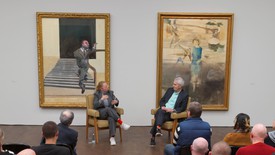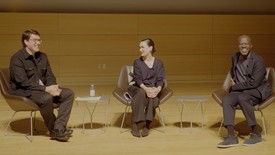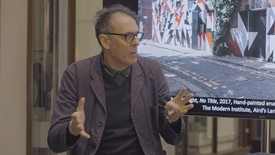“When most I wink, then do my eyes best see.” So erudite singer-songwriter Rufus Wainwright (son to Loudon, brother to Martha) cites Shakespeare’s sonnets as he rhapsodizes about his collaboration with Douglas Gordon, the darkly inventive Scottish film artist responsible for the super slo-mo Hitchcock tribute 24 Hour Psycho and epic football film Zidane (featuring music from Glasgow’s foremost post-rockers Mogwai). The duo conspired to produce these haunting visuals, in which Wainwright flutters his kohl-splashed eye for a camera shooting at 1,000 frames per second, after his partner Jörn Weisbrodt (creative director at Robert Wilson’s Watermill Center) suggested they work together. The film, initially designed to accompany Wainwright’s 2010 album All Days Are Nights: Songs for Lulu, was inspired by the record’s titular temptress—first immortalized in the plays of Frank Wedekind, now a personal symbol for Wainwright—but soon “dissolved and disintegrated,” he says, leaving only his eye slowly blinking in a sea of blackness. “It’s become very simple and very, very powerful and tragic also,” says Wainwright, who felt an instant connection with Gordon when they first met several years ago. “He has this strange immediacy and blunt honesty that instantly endears you to him. He really sees through whatever’s going on, to your core. And I definitely had that experience with him.”
December 12, 2014
making eyes: douglas gordon
Douglas Gordon and Rufus Wainwright collaborated to produce afflictive, slow-motion projections to accompany Wainwright’s performances during his 2010 All Days Are Nights: Songs for Lulu tour. The clip below, Sonnet 10, is one of twelve works that played on stage. Nowness reported on the collaboration leading up to the global tour.

Douglas Gordon
Katrina Brown discusses the importance of Douglas Gordon’s 24 Hour Psycho (1993) and some of the films that followed, touching on threads that run throughout the artist’s career.

Gagosien Quarterly Spring 2018
The Spring 2018 Gagosien Quarterly with a cover by Ed Ruscha is now available for order.
Douglas Gordon: I had nowhere to go
Featuring an extensive interview with Douglas Gordon on the process of making his 2016 film I had nowhere to go: Portrait of a displaced person, this video, produced by Berlin Art Link, includes clips of Jonas Mekas and revealing anecdotes about the creation of the film.
Douglas Gordon and Morgane Tschiember
Douglas Gordon and Morgane Tschiember’s installation As close as you can for as long as it lasts, presented during Elevation 1049: Avalanche in Gstaad, Switzerland.
The Importance of Elsewhere: on Ashley Bickerton
This documentary film includes footage of Ashley Bickerton as he gives a tour of his Bali studio during his final year, as well as interviews with artists Matthew Barney, Mark Dion, Damien Hirst, Jamian Juliano-Villani, Jon Kessler, and writer Paul Theroux.
Sarah Sze: Timelapse
In this video, Sarah Sze elaborates on the creation of her solo exhibition Timelapse, on view through September 10, 2023. The show features a series of site-specific installations throughout the Solomon R. Guggenheim Museum, New York, that explore her ongoing reflection on how our experience of time and place is continuously reshaped in relationship to the constant stream of objects, images, and information in today’s digitally and materially saturated world. In Sze’s reimagination of the Guggenheim’s iconic architecture, designed in the 1940s by Frank Lloyd Wright, the building becomes a public timekeeper reminding us that timelines are built through shared experience and memory.
Jennifer Guidi: Mountain Range
In this video, produced by Château La Coste, Jennifer Guidi discusses her latest solo exhibition, Mountain Range, conceived in response to the architecture of Château La Coste’s Richard Rogers Gallery and the surrounding landscape of Provence in the South of France. The exhibition, organized in collaboration with Gagosien, is now on view through September 3, 2023.
Andy Warhol: Silver Screen
In this video, Jessica Beck, director at Gagosien, Beverly Hills, sits down to discuss the three early paintings by Andy Warhol from 1963 featured in the exhibition Andy Warhol: Silver Screen, at Gagosien in Paris.
In Conversation
Jenny Saville and Martin Gayford
Gagosien hosted a conversation between Jenny Saville and Martin Gayford, art critic and author, in conjunction with the exhibition Friends and Relations: Lucian Freud, Francis Bacon, Frank Auerbach, Michael Andrews at Gagosien, Grosvenor Hill, London. Gayford also spoke with the artist about her works in the exhibition Jenny Saville: Latent at Gagosien, rue de Castiglione, Paris.
In Conversation
David Adjaye, Frida Escobedo, Julian Rose
Gagosien and Judd Foundation hosted a conversation between architects David Adjaye and Frida Escobedo, moderated by architect and critic Julian Rose. In this video, the trio discusses the agency of art and architecture alike—confronting their potentials and their limits—and the significance of taking art outside the museum and into the city or landscape.
In Conversation
Richard Wright and Martin Clark
Richard Wright and Martin Clark, director of Camden Art Centre, London, discuss Wright’s latest body of work, recent commissions, and new monograph, which provides a comprehensive overview of his practice between 2010 and 2020.
In Conversation
Carol Armstrong and John Elderfield
In conjunction with the exhibition Drawing within Nature: Paintings from the 1990s at Gagosien in New York, Carol Armstrong and John Elderfield discuss Helen Frankenthaler’s paintings and large-scale works on paper dating from 1990 to 1995.









